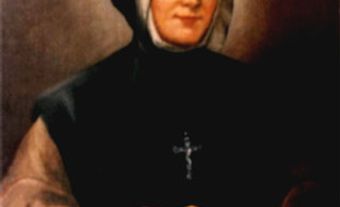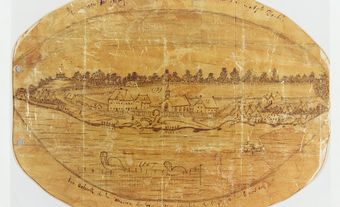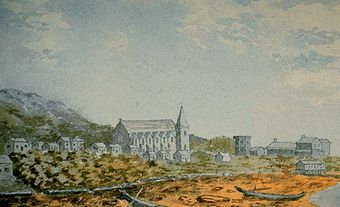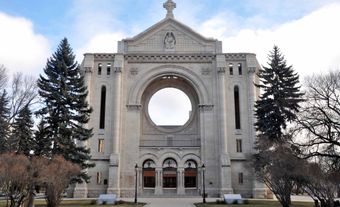The Grey Nuns refer to six distinct Roman Catholic religious communities of women. Their origins can all be traced to the Sisters of Charity of theHôpital Général de Montréal founded by Marie-Marguerite d'Youville in the mid-18th century.

Marie-Marguerite d’Youville, Founder of the Grey Nuns
In 1737, Marie-Marguerite d'Youville (Marguerite Dufrost de Lajemmerais, widow of François Youville) formed a charitable lay association with three other women to tend to the sick and poor in Montreal. The association was formed in secret. This is because new religious communities could not be officially founded in New France at that time. Existing communities came from France and relied on the King for funding. It would not have been acceptable to ask the King for money to start a new one.
Marie-Marguerite d'Youville and her associate Sisters lived at the Le Verrier house on Notre Dame Street in Montreal. There, they received, fed and sheltered both men and women in difficulty (see also Old Montreal). This inclusive approach to caring for people was significant. The General Hospital (Hôpital Général de Montreal) only welcomed men at that time, and there had been no one to care for women who needed help. In January 1745, a fire destroyed the house. Over the next two years, their association was forced to move many times.
In 1747, the association took on the management of the bankrupt Hôpital Général de Montreal, founded in 1692 by François Charon de La Barre. D’Youville was known for her strong administrative skills, business acumen, piety and devotion to the destitute. She reorganized it into a hospice for the elderly, the disabled, foundlings (children who had been abandoned by their parents), orphans and so-called "fallen women" (women who had had sexual relations or given birth to children out of wedlock).
The brothers who had run the hospital were very popular with the public. The general population resented the change and mocked the sisters as "les sœurs grises," which translated as "grey nuns," or “tipsy women” in reference to d'Youville's late husband who was a bootlegger. (The word “gris” in French could mean either grey or drunk.)
In 1750 civil and ecclesiastical authorities wanted to merge the Hôpital Général of Montréal with the Hôpital Général of Québec. D’Youville disagreed with this proposal and disputed with Intendant Bigot, one of the authorities. After much negotiation, the Sulpicians interceded in Paris, France, and on 3 June 1753, King Louis XV gave the community legal status. Madame d’Youville officially became administrator of the Hôpital Général de Montréal.
In 1755, their religious community was officially recognized. The women finally began their life as the Sisters of Charity of the Hôpital Général de Montréal, but they kept the nickname sœurs-grises, or Grey Nuns, and their traditional grey habit, as reminders of their humble origins. They ran several businesses including farms, an orchard, a mill and a bakery to finance their work.
During the smallpox epidemic of 1755 and the Seven Years' War, their institution truly became a hospital.

Expansion in the 19th and 20th Centuries
In the 1840s, the Grey Nuns expanded to other locations. At first, they decided to follow the pattern of cloistered communities by having each foundation become an independent community.
In 1840 Sister Marie-Michel Archange Thuot founded the Sisters of Charity of St-Hyacinthe in Quebec with three other women: Sisters Tharsile Guyon, Émilie Jauron and Honorine Pinsonneault. Thuot was superior of this new foundation until 1845.

In 1844, they ventured farther afield to St Boniface, Manitoba, on the Red River after Bishop Joseph-Norbert Provencher successfully persuaded some of the Grey Nuns of Montréal to move to St. Boniface to assist with the missionary work in Manitoba. Four women from the congregation, Sisters Marie-Louise Valade, Eulalie Lagrave, Gertrude Coutlée and Hedwidge Lafrance, were chosen to go to the Red River settlement. They would travel there by canoe. The fifty-eight day journey was a difficult one.
In 1845, Sister Elisabeth Bruyère, of the Grey Nuns of Montreal, founded a religious community in Bytown (later known as Ottawa). The community of the Grey Nuns of Bytown became independent in 1854.
In 1849, the Grey Nuns opened an orphanage in Québec City. Administrators appointed Sister Marcelle Mallet, and Sisters Eulalie Perrin, Julie Pilon, called Ste-Croix, Elmire Clément, and Perpétue Thériault, as well as an Irish novice, Alice Dunn. They travelled from Montreal to Quebec City by steamboat.
In 1855 the Grey Nuns established a community in Toledo, Ohio, to tend to the sick and those who had been orphaned by cholera, thus establishing their ministries in the US.
In 1858, Bishop Alexandre-Antonin Taché convinced three nuns, Sisters Emery, Lamy, and Alphonse to move to Lac St. Anne in Alberta. The three Grey Nuns moved to what is now the City of St. Albert, AB. Upon their arrival in 1863, they established an orphanage. One year later, again responding to the needs of the community, the orphanage evolved to incorporate a school, and hospital, and by 1949 the foundation included a long-term care facility for seniors. From the modest beginnings of the school that was run from the convent in St Albert, the St. Albert Catholic School District has become the oldest school division in Alberta.
Some of the Grey Nuns foundations in Canada have existed for more than 150 years. Several facilities, notably in Alberta, Saskatchewan and Manitoba, were established in 1920-40 during the Great Depression. With the exception of St-Boniface, which needed the support of the Montreal community, these foundations became centres that maintained the traditions of the original order while adapting their work and spiritualities based on the needs of each community. Another development saw two English-speaking offshoots of the Ottawa community established in Yardley, Pennsylvania (1921) and Pembroke, Ontario (1926).
Impact and Legacy
The Grey Nuns have devoted themselves to compassionate services and supporting society's most vulnerable through their charitable organizations, long-term care facilities, hospitals, respite centres and schools. Recently, many facilities on the prairies and the Atlantic Provinces that have been run by the Grey Nuns have refocused their support from healthcare and education to social support. Communities that flourished into the 1960s experienced a decline through the 1990s, but the Grey Nuns continue their work in Canada and in the United States and South America.
Due to the decreasing number of Grey Nuns, the stewardship of many of their facilities in Canada are gradually being taken over by local and provincial administrators. For example, in 2004, the Grey Nuns announced they would sell the Mother House, located at the intersection of Guy Street and René-Lévesque Boulevard in Montreal and designed by renowned architect Victor Bourgeau, to Concordia University.
The university officially purchased the Mother House in 2007. The site was eventually re-purposed into new student residences, individual and group study spaces, and a Reading Room in the former chapel. Concordia’s Grey Nuns Building officially opened on September 15, 2014, and the property is designated to the Historic Sites and Monuments Board of Canada.

 Share on Facebook
Share on Facebook Share on X
Share on X Share by Email
Share by Email Share on Google Classroom
Share on Google Classroom






